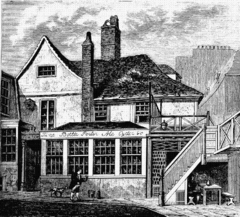London Beer Flood
 Toten Hall house in Tottenham Court Road. | |
| Date | 17 October 1814 [1] |
|---|---|
| Location | St. Giles, London, England |
| Coordinates | 51°31′00″N 0°07′49″W / 51.51656°N 0.13014°W |
| Cause | Structural failure |
| Casualties | |
| 8 dead [1] | |
| Unknown number injured | |
The London Beer Flood happened on 17 October 1814[2] in the parish of St. Giles, London, England. At the Meux and Company Brewery[1] in Tottenham Court Road,[1][3] a huge vat containing over 135,000 imperial gallons (610,000 L) of beer ruptured, causing other vats in the same building to succumb in a domino effect. As a result, more than 323,000 imperial gallons (1,470,000 L) of beer burst out and gushed into the streets. The wave of beer destroyed two homes and crumbled the wall of the Tavistock Arms pub, killing teenage employee Eleanor Cooper under the rubble.[4] Within minutes neighbouring George Street and New Street were swamped, seriously injuring a mother, and killing a daughter and young neighbour who were taking tea. The beer also surged through a room of people gathered for a wake, killing five of them.[5]
History
The brewery was among the poor houses and tenements of the St Giles Rookery, where whole families lived in basement rooms that quickly filled with beer. At least eight people were known to have drowned in the flood or died from injuries.
The brewery was eventually taken to court over the accident, but the disaster was ruled to be an Act of God by the judge and jury, leaving no one responsible.[6] There were speculations of corruption regarding the court ruling but no official statement was made. The company found it difficult to cope with the financial implications of the disaster, with a significant loss of sales made worse because they had already paid duty on the beer. They made a successful application to Parliament reclaiming the duty which allowed them to continue trading.[7]
The brewery was demolished in 1922, and the Dominion Theatre later occupied part of the site. In 2012, a local pub, the Holborn Whippet, started to mark this event with a vat of porter brewed especially for the day.[citation needed]
Fatalities
| Name[8] | Age |
|---|---|
| Hannah Bamfield | 4 |
| Sarah Bates | 3 |
| Catherine Butler | 63 |
| Eleanor Cooper | 15–16 |
| Mary Mulvey | 30 |
| Thomas Mulvey | 3 |
| Ann Saville | 53 |
| Elizabeth Smith | 27 |
See also
References
- ^ a b c d Greenberg, Michael I. Disaster!: A Compendium of Terrorist, Natural, and Man-made Catastrophes. Jones & Bartlett Publishers. p. 156. ISBN 0-7637-3989-8.
- ^ The Oxford Companion to Beer. p. 48.
- ^ Rennison, Nicholas (2 November 2006). The Book of Lists: London. Canongate Books Ltd. ISBN 978-1-84195-676-3.
- ^ London Beer Flood at Expages.com (archived version)
- ^ The London Beer Flood of 1814
- ^ Rennison, Nick (2010). Book of Lists London. Canongate Books. p. 149. ISBN 978-1-84767-666-5. Retrieved 13 December 2013.
- ^ Industries: Brewing (British History Online) accessed 10 January 2009
- ^ [1] The Times (London), 19 October 1814 – via TimesOnline (subscription required)
External links
- "Beer Flood Claims Nine Souls" by Alan Bellows, Damninteresting.com (September 28, 2005)
- "A Brew to a Kill" by Barbara Mikkelson at Snopes.com
- "The London Beer Flood of 1814", BBC
